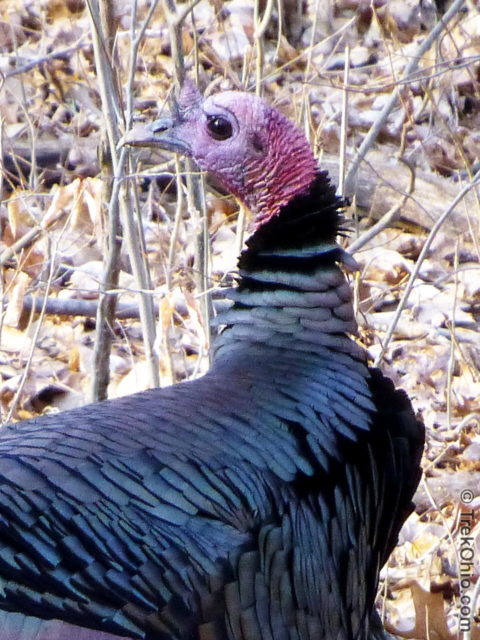
This past Saturday I stopped by Blendon Woods Metro Park in central Ohio. While going on a walk there I watched a large flock of turkeys slowly move from one side of the trail to the other. The females were the most shy, and they scooted across the trail lickety-split. The males, however, took their time, often pausing in the middle of the trail as if to say, “I’m big and tough, and if anything you should be intimidated by me.” Consequently the photos below are all males, what with them posing and all.
Which brings us to the question of how you can tell a turkey’s gender. Let’s start by looking at the male turkey below.
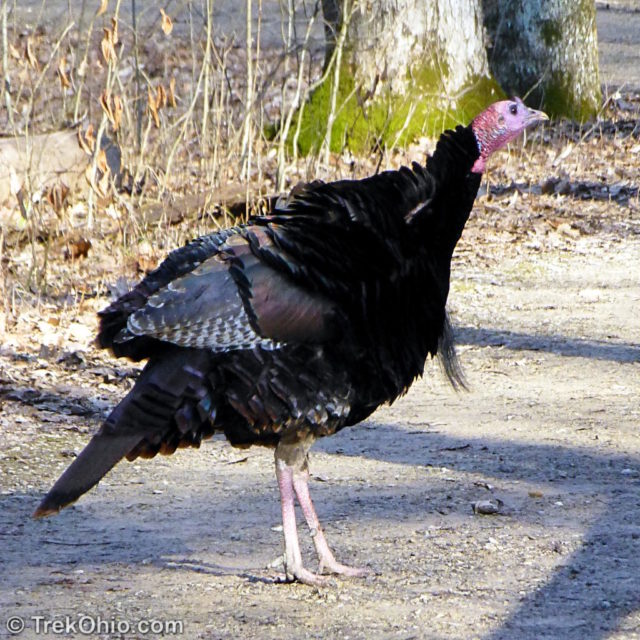
Male turkeys are called, “Toms” or “gobblers.” The two key things to look for in a male turkey are spurs and a beard. Of the two, the spurs are the more reliable characteristic. If you look at the back of the turkey’s legs about one-third of the way up from the feet, you’ll see a talon or claw-like structure. This is a spur. Male turkeys can use these spurs if they get in a fight amongst themselves, or if they are trying to defend themselves from a predator. The females, called “hens”, do not have spurs.
The beard is what looks like a tuft of hair emerging from the middle of the bird’s chest. The beard is really a tuft of modified feathers. In my reading I’ve learned that older birds have longer beards. This seems to suggest that the beard grows continually and doesn’t fall off when the bird molts. However the beard is not as dependable a characteristic as the spurs in determining gender because 10% or so of the females also have beards. Yes, they are bearded ladies. 🙂 Apparently the female’s beard is much shorter and not nearly so splendid as the male’s, but there you go. I’m reminded of the female dwarves in Tolkien’s Lord of the Rings who were also said to have scrawny, little beards.
One more note about the turkey above. In order to get some eye-level photos, I was squatting in the trail. He paused right in front of me and fluffed up his feathers. I think he was trying to impress me with his size. I saw this behavior again and again as the males crossed the trail, but not when the females did so. Another trick employed by the male turkeys to look bigger was to spread out their wings as they passed in front of me. Despite extending their wings, they made no attempt to fly. I think they were using their wingspan to look as big as possible… you know, in case I was getting any ideas about trying to grab one.
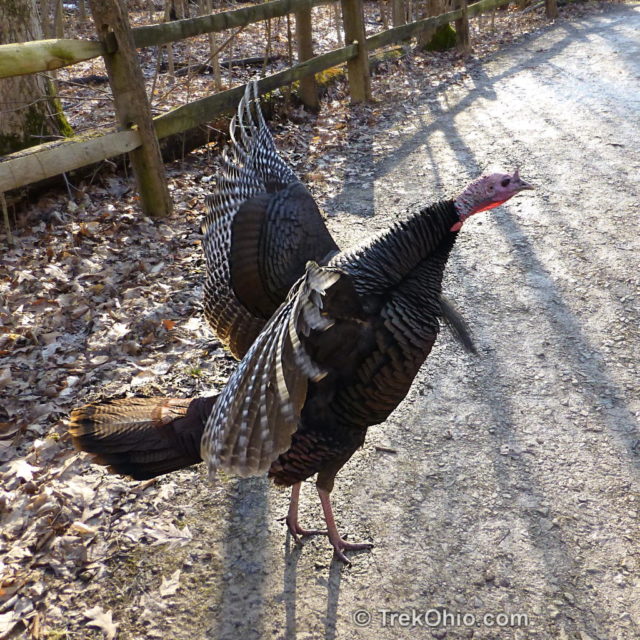
If a potential predator does try to get a turkey, surprisingly it doesn’t usually try to fly away. It is much more likely to take off running. It turns out that wild turkeys can run faster than a galloping horse, so running might not be as bad a strategy as it first seemed. Despite their preference for running when spooked, wild turkeys are perfectly capable of flying. Turkeys don’t soar high in the sky like turkey buzzards, but they can fly as far as a mile near the ground. To my amazement one turkey was clocked flying 60 mph as it flew along side a car that was going that speed. Turkeys regularly fly up into a tree to roost at night, and they fly down in the morning to begin a day of foraging for food on the forest floor. Young turkeys develop the ability to fly about two weeks after hatching.
Although domestic turkeys are really the same species as wild turkeys, the reason domestic turkeys can’t fly is because they’ve been selectively bred to have unusually large breast muscles since turkey white meat is delicious! However this extra muscle up front has thrown off the whole flight mechanism. In addition domestic turkey are just too heavy; they weigh almost twice as much as a wild turkey. The wild turkey is one of only two native, North American animals that people domesticated. Guess what the other one was.
Because of the lighting in the above photos, the turkey’s feathers look dark brown, or even black. Well it turns out their feathers are dark brown, but if the lighting is right, you can see that turkey feathers are iridescent. The iridescence mostly gives the feathers a coppery look, however, if the light hits the feathers just right, you can see a variety of colors: blues, purples, reds, even greens.
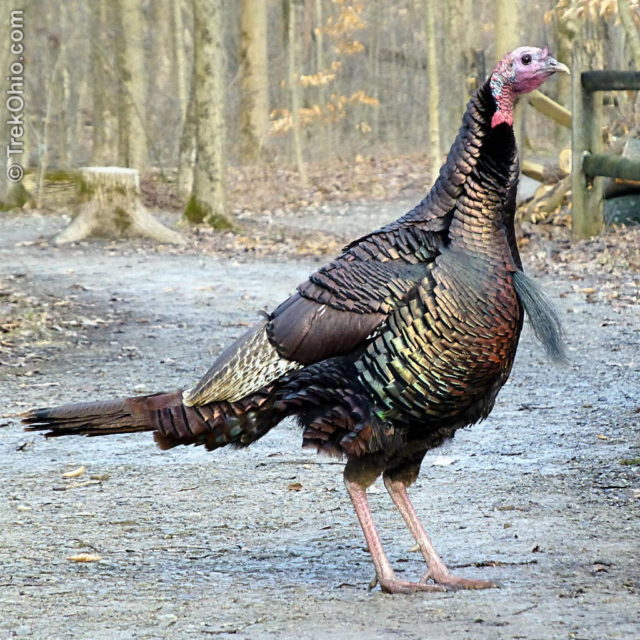
Although I could see lots of turkeys on either side of the trail, I took most of my photos while the turkeys were crossing the trail because that’s when I had a clear shot. However, I do want you to see at least one photo of a turkey in its natural, wooded habitat. Check out how the coloration of the feathers helps the turkey to blend in with the log behind it.
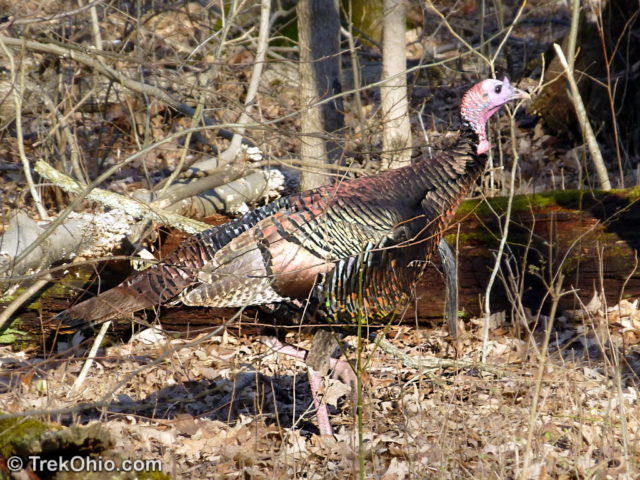
Let’s take another look at the turkey’s head.
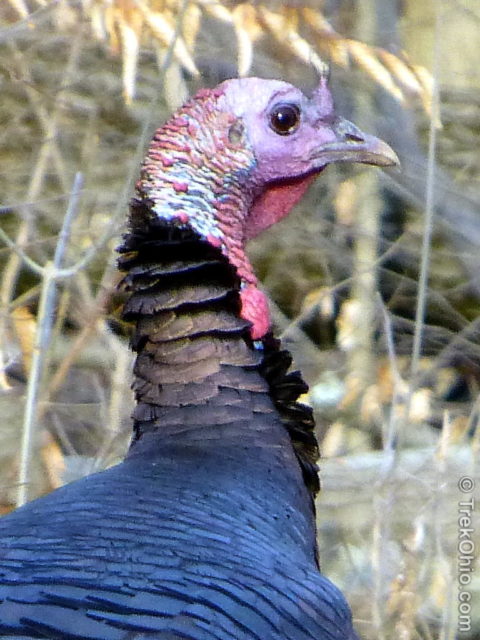
If you look at the photo above, you’ll see a fleshy cone sticking up between the bird’s eyes and beak. This fleshy cone is called a snood. The pinkish skin hanging from the neck of the bird is called a wattle. The wrinkly flesh to the rear of the head and neck is called carancle. But what surprises me most is that the turkey doesn’t have any feathers on its head. I have heard repeatedly that it is adaptive for vultures to have feather-free heads since they eat carrion, and their baldness prevents bacteria-laden gore from getting stuck in their feathers. However turkeys don’t eat carrion, so this doesn’t explain a turkey’s baldness. Turkeys get 90% of their nutrition from vegetable sources, such as acorns and fern fronds. Their animal food consists mostly of insects and larva along with the occasional small amphibian or other little animal. I haven’t been able to find a clear explanation as to why their baldness is adaptive, but here’s my best guess (correct me if you’ve heard otherwise!).
The flesh on the turkey’s head turns colors. The color ranges in hue from white, to blue, to pink, to red. The change in color is one of the many ways that the Tom puts on a display during the breeding season for the hens. His forehead turns white, but his face and wattle turn a bright red. In addition to this change in color during the mating season (in April), the head colors vary all year long and appear to communicate the bird’s emotional state. The turkey’s face can turn white as a sheet when its scared, while an angry turkey’s face can turn red with rage. Since turkeys live in flocks, it could be that the changing colors of their fleshy faces helps them communicate their emotional states to one another. I’ve also wondered if the light, mottled coloring of their heads helps their heads to blend in with the leaf litter when they are head down and looking for food on the ground.
You may have heard that in 1782 Benjamin Franklin championed adopting the wild turkey as our national symbol. However, I had never heard the whole story before. Apparently his choice was in keeping with the Yankee spirit of the day: Don’t tread on me. According to Franklin the turkey should be our national symbol because the wild turkey is…
a bird of courage [that] would not hesitate to attack a grenadier of the British guards, who should presume to invade his farmyard with a red coat on.
In contrast Franklin said that the bald eagle was a lazy bird that would happily steal its food if it could.
Since this is an Ohio blog, it’s worth noting that wild turkeys were extirpated in Ohio by 1904. The word, extirpated, is just a fancy way of saying “all gone.” It’s kind of like becoming extinct, but only within a limited geographical region. The reason that the wild turkey disappeared from Ohio is the same reason that deer and just about all other wild animals disappeared from Ohio. Almost all of Ohio had become farmland. The industrial revolution, plus efficiency gains in agriculture, prompted country folk to become town and city folk. This allowed more and more agricultural land to revert to forest once again, allowing for animals to wander back into the state, or, as in the case of the wild turkey, to be carefully reintroduced. In 2011 Ohio had an estimated wild turkey population of 230,000 birds. Nonetheless agriculture continues to play an important role in our economy. About 55% of Ohio is still farmland.
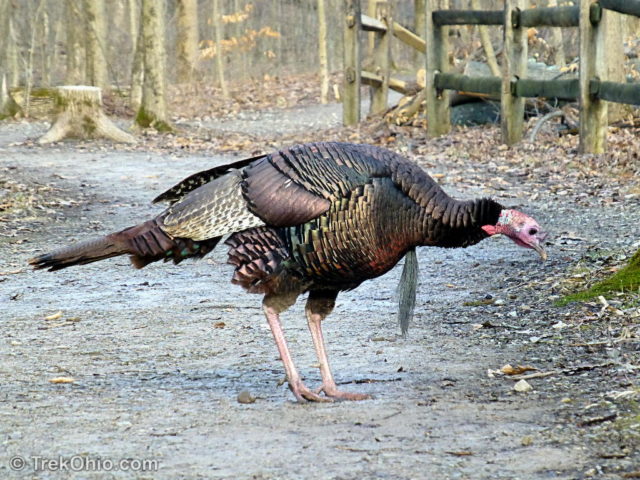
Additional information
- TrekOhio: Blendon Woods Metro Park
- Wikipedia: Wild Turkey
- All About Birds: Wild Turkey, Identification
- ODNR Division of Wildlife: Wild Turkey
- ADW: Meleagris gallopavo: INFORMATION, by University of Michigan
- Wild Turkey – Meleagris gallopavo – NatureWorks
- Meleagris gallopavo, from the federal government’s database
- Wild Turkey (Meleagris gallopavo) | BirdNote
- Turkey Calling – Real or Unreal | BirdNote
- The Wild Turkey — I think this is Audubon’s original description of the bird, with his own illustration
- Wild turkey videos, photos and facts – Meleagris gallopavo – ARKive
- Wild and domestic turkeys: birds of a different feather, a South Carolina Dept. of Natural Resources News Release
More on Birds
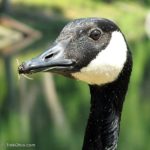
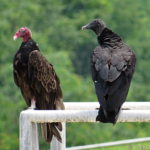

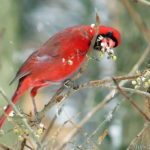
There is one other way to differentiate between male and female turkey–and this holds true even with the young. Males “poop” is in the shape of a “J” whereas the female produces just a glob. So if you are that close to a bird again and cannot tell, as when young they may not have gotten that spur yet (if male), then wait for them to “poop”. While this thought may disgust some, scat is often used to distinguish species in the wild.
Great captures! They do have a beautiful body of feathers.
Thanks, Donna.
I love these guys…. So fascinating, great post. I can’t believe they disappeared from your state, though! WOW.
They’re everywhere in my mother’s area (near the Pinelands in NJ), and when I first saw them fly, so gracefully, I was in awe.
Love those Blendon Woods turkeys! We need to get over there soon! Your pictures are terrific.
Thank you, Deb! All of my previous photos of the turkeys in Blendon Woods were of their derrieres as they fled from me, so I was delighted that these ones agreed to pose for a photo shoot. 😀
I too love your blog. I can’t get out and about as much as I used to so your blog keeps me in touch with the natural world of Ohio. Thank you and “keep them coming”.
Patricia, I really appreciated your comment. Our state has so much natural beauty; it is gratifying to learn that you have been accompanying us on our hikes from the comfort of home.
Great pictures, and very good insight! Please keep them coming, Love this
Thank you, Keith. 🙂